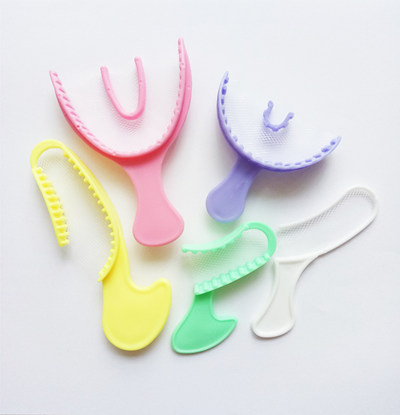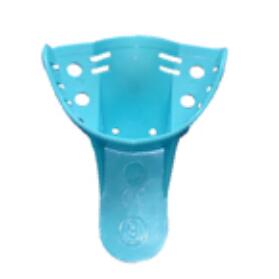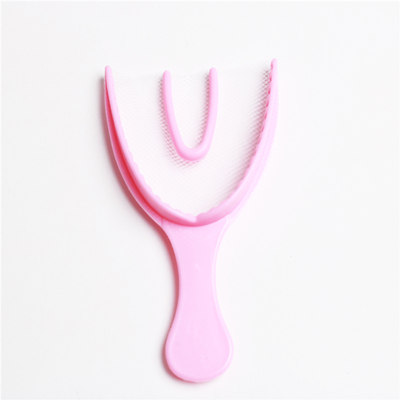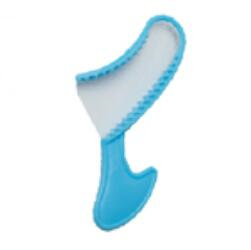Dental Impression Trays and Bite Trays: What’s the Difference?
Dental impression trays and bite trays are often confused for one another. However, they are actually two different devices that serve different purposes during dental procedures. Impression trays create a detailed mold of the patient’s teeth to be used in making dentures or other prosthetic devices. Bite trays help align the jaws for accurate diagnosis of temporomandibular joint dysfunction (TMJ). This blog post will explore the differences between these two types of dental tools, as well as their applications!
Impression Trays
An impression tray is a dental device that captures detail to enable dentists to better create prostheses. It creates an accurate impression of the patient’s teeth so that when the prosthesis is created it fits perfectly, making for much more comfortable teeth. They often capture more detail than a simple x-ray or photo does, enabling clear analysis of tooth shape, gum tissue health, bone structure, and much more. Dentists consult these molds when creating prostheses for patients.

Bite Trays
A bite tray is also called a bite registration tray or triple tray which is a dental device that helps to align teeth for diagnosis of temporomandibular joint dysfunction (TMJD). Bite trays are medical devices that conform to an individual’s head and jaw to help determine if they have any problems with their TMJ joint. It may also be used during dental work to help analyze teeth and bone structure.
Bite trays are often confused with dental impression trays, which create a mold of teeth in order to make dentures or other prosthetic devices.

Function differences between the two types of trays
There you have it! These two dental devices may look similar but serve different purposes that must be taken into account when creating prostheses. Bite trays are used to help diagnose TMJ while impression trays capture teeth and bone structure for tooth replacement.
What do impression trays and bite trays look like?
They can take many types and sizes!
- Impression trays have 10 ten sizes: 1# upper large, 2# lower large, 3# upper medium, 4# lower medium, 5# upper small, 6# lower small, 7# quadrant UL/LR, 8# quadrant UR/LL, 9# anterior upper, 10# anterior lower for dentists to choose the suitable size for patients. They are perforated and good for impression materials works.
- According to the material difference, Impression trays are available in metal material, plastic material.
The metal trays include aluminum, nickel-plated, and stainless steel trays, which are available in perforated and solid for rigidity. They are solid, nonperforated trays for use with solid impression materials, such as red compound or fast-set impression plaster No. 2.
The plastic trays include disposable ABS plastic material, autoclavable PP plastic material. The wall of PP type is a little bit thinner than ABS type, the widely used one is ABS disposable material which is convenient for clinics management and safe with disposable function to avoid cross-infection.
3.The types of impression trays images are as bellow.




4.Bite trays, on the other hand- do not have such a large number of sizes available since they are used in smaller quantities than impression trays during routine care or dental work. Bite trays come in five different sizes: anterior, quadrant, posterior, sideless, full arch. They are often made of plastic specially designed walls with tear resistant nylon mesh.
5.The shapes and sizes of bite registration trays images are as bellow:





How to choose the right tray for your needs?
Bite trays are often used during routine dental work to help align teeth. Impression trays are more commonly used when creating prostheses for patients, such as dentures or implants.
How long can bite/impression trays be worn? While impression trays must be custom-made by a dentist for each patient, most bite trays are worn for around twenty minutes. Bite trays are often used during routine dental work, while impression trays may be applied in larger quantities over longer periods of time to create the necessary molds.
Benefits of using bite trays vs impression trays
The benefits of using bite trays include:
-Alignment of jaw joints to help diagnose TMJ problems
-Helping tooth alignment during dental work such as removing wisdom teeth or fixing cavities
The benefits of using impression trays include:
-Capturing detail for more accurate prostheses that fit perfectly, making them much more comfortable. These are often used when creating dent.
How do they help different kinds of dental work such as orthodontics, implants or dentures? The applications for the use of impression trays are more extensive than those for bite trays due to their detailed nature and ability to capture detail better. They may be used in any kind of dental.
How to use impression trays along with impression material?
The most often used irreversible hydrocolloid is alginate. Alginate is a naturally-occurring polymer usually obtained from brown seaweed. This biomaterial has numerous applications in biomedical science as well as engineering due to its biocompatibility. How Dental Impressions are Created. Impression material goes on an impression tray. Dental impression trays hold the impression material while the impression is being created intraorally, and then provide a firm backing to make sure the impression is free of distortions as it finishes setting. Then, the tray goes in the mouth. The trays are designed for different mouth areas and included quadrant trays that cover half an arch and fill and full trays that cover the complete maxillary or mandibular arch. Please follow bellow steps:
#1. Gather materials for your impression tray
Some of these materials include: dental dams, aluminum foil, cotton swabs, rubber gloves, wax paper, water spray bottle. Depending on the size of your impression tray you may need more materials.
#2. Wrap the patient’s teeth with dental dam or aluminum foil
The teeth should be covered in order to avoid getting wet during the process of making the mold. Aluminum foil is typically used when doing smaller molds and dental dams should be used when doing larger molds and will take longer to make.
#3. Apply the blue/red material over the teeth and around them while spraying it with water to keep it moistened.
This step is very important since the material will stick to dry areas and be unpractical if it gets too wet.
How often should dentists replace bite trays and impression trays if they are consumed or broken?
It is important to replace trays on a regular basis so they do not become dirty and unusable. Some dental professionals recommend replacing them after one use, but others say it depends on the type of material being used. For example, ABS plastic impression trays, plastic bite trays are disposable. Metal alloy and PP plastic impression trays are autoclavable. They can be reusable.
If the dentist has broken or consumed trays, they cannot use it for patients. The patient will not get the treatment that is needed and may find themselves in pain.
Where you can buy both types of trays online and locally?
There are many places where you can purchase impression or bite trays. If you are a dentist. You can buy both types of trays online and locally. Some of these include Dental supply stores, online retailers, your oral surgeon’s office. There may also be kits available for sale which contain more extensive materials to assist with the making of dental impressions such as plaster bandages.
If you are a dealer. You can buy from local brands wholesalers. Or import from China directly who supply one-stop solution dental supplies, such as GUARDDENT (HUBEI GUARDDENT MEDICAL TECHNOLOGY CO.,LTD).
If you are a wholesaler. We’d like to recommend GUARDDENT (HUBEI GUARDDENT MEDICAL TECHNOLOGY CO., LTD) which is a leading manufacturer to produce all kinds of dental supplies.
How much they cost on average?
- Impression trays at your local retailer or online for approximately $8-$18 locally per bag.
The package of 1 bag is normally 12 pcs.

2. Bite trays are approximately $13-$24 locally per box.
The package of 1 box for anterior is 35 pcs. 1 box for posterior is 50 pcs. 1 box for quadrant is 35 pcs. 1 box for sideless is 50 pcs. 1 box for the full arch is 30 pcs.
Bite tray has two kinds of colors for option, one is a beige color, another one is anterior with purple, posterior with green/blue, quadrant with yellow, sideless with white, full arch with pink.




3. If from China for Impression trays is approximately $1.1-$1.6 per bag. And bite trays is approximately $3.4-$4.5 per box according to different wholesale quantity and trade terms.
You can learn more about the differences between these two dental supplies by taking a look at our website or giving us a call. We have friendly, knowledgeable staff members who are always willing to provide you with all of the necessary information so that you receive the exact information that you need.
How does dealers or wholesalers choose the reliable vendor from China?
Dealers or wholesalers should be careful when choosing a reliable dental supplies vendor from China. There are many online dealers and wholesalers to choose from which makes it difficult to determine who is legitimate and who will provide good service. Here’s a list of things you should keep in mind:
1) Know what you want and how much you’re willing to spend
How much can I sell?
2) Compare prices with other competitors in the community so you know if the dealer is charging an appropriate price for their items. You may also want to search for local suppliers for discounts or coupons or visit your local hospital warehouse.
3) Compare quality to make sure the company has a good reputation and stay away from companies with complaints filed against them.
4) Make sure they have complete certificates for your smooth import.
Except for those tips, there are a lot of things that need consider. You can inquiry about the vendors to get more information or visit the blog: How to import dental supplies from China? And contact us for more details.
